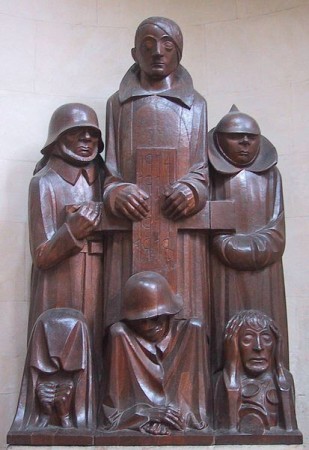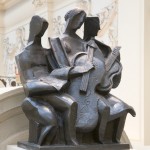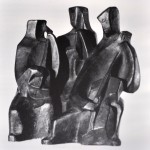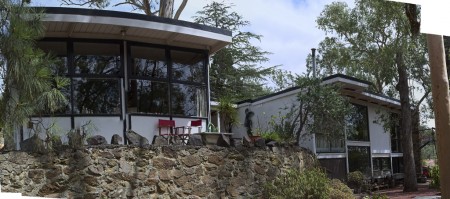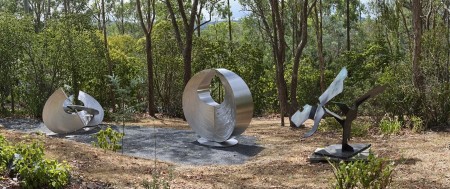Inge King – The Early Years: From Berlin to Melbourne
Berlin
Inge King (née Ingeborg Viktoria Neufeld) was born in Berlin on 26 November, 1915, the youngest of four girls in a well-to-do Jewish family . ((Inge King, personal communication. Her year of birth is incorrectly given in many published sources as 1918. As a result, erroneous dates have been assigned by inference to a number of the events in her early life which, in turn, have led to inconsistencies in accounts of her life. These inconsistencies have been resolved as far as possible.)) Her older sisters were adults by the time she was a small child. King says that her childhood was not particularly artistic, though her mother was “quite a creative woman.” “I grew up in a very European middle-class surrounding with a nanny, … I didn’t see that much of my parents because my early childhood from that point of view was very sheltered probably. I was in many ways fairly extrovert. I loved sport. I loved particularly gymnastics and I was quite good at them. I often say I grew up in the Berlin Zoo because I used to play there. … I drew the animals as well. … [I]n European cities, children are taken for walks, which is very different and also very different from England. But in the park … we had a great deal of freedom. We played games and we had a lot of fun.” ((Inge King in an interview with James Gleeson for the research library, National Gallery of Australia, Canberra, on 18 October 1979, transcript p. 21. Personal details and quotations in this essay, unless otherwise noted, have come from pages 21-32 of this transcript.))
But after WWI, conditions in Germany became increasingly difficult. Germany had lost the war and was faced with substantial reparations to the victorious powers. The period of the Weimar Republic (1918-1933), though a culturally stimulating time, was never stable, with continuous political and social unrest and lawlessness, exacerbated by the hyper-inflation of the early 1920s and later by the depression, which started in 1929 in the US and then spread to Europe. During that period, things became increasingly difficult for the Neufeld family. In the late 1920s, her father, by now elderly, developed Parkinson’s disease. King says that “[he] was exceedingly sick and there were also many financial difficulties. … from that stage onwards I saw things that many young people nowadays probably wouldn’t experience”.” ((Gleeson, 21.)) By the time he died in 1930, when she was 14, the family had lost most of its money. Her older sisters were able to support King to stay at school until she finished, in 1932. She received a good education at a school that encouraged its female students: an important influence on her later life.” ((Gabriella Costovich: “Thriving in a cultural void”, The Age, 22/11/03.)) King would have liked to have gone on to university, possibly to study medicine, but, financially, that was out of the question. She left school and got a job as a window-dresser with a department store; a job she did not particularly like.
King was 17 when Hitler came to power on 30 January 1933. Her older sisters were married by this time. The two eldest and their partners decided to emigrate: one to Palestine, taking their mother with them; the other to the US. King was not close to the third sister, so by 1934, when she was 18, she was effectively on her own. ((Her third sister subsequently died in the holocaust.)) She went to live with other young people in a small Zionist commune, where she worked for them, in the house and in other activities, in exchange for board and lodging. She said of this experience: “I owe them a lot … This commune … gave me or taught me some independence, which was invaluable”, and, most importantly, taught her “to survive without money”. ((Gleeson 21.))
King was starting to think about being an artist, though this was really a second choice. “I would have preferred a university career by a long shot at the time. But I felt [art] was the only other way that I could go on studying the way I wanted to and felt I could develop the way I wanted to.” ((Gleeson 21)) Art was something she could do with minimal resources, so long as she could support herself. The commune had taught her how to live on very little. But art was not something she could do within the commune. She left and moved into a room that she could occupy in exchange for doing housework in the morning.
In the early twentieth century, Berlin had become an important centre of modernism in all of the arts.” ((Peter Gay: Weimar Culture: The outsider as insider, 2-9.)) The main art movement at this time was German Expressionism, a movement King later described as “violent and tragic”.” ((Gleeson, 22.)) The Nazis considered such art to be decadent (entartete Kunst) and later attempted to suppress it.”” ((Richard J. Evans: The Third Reich in Power, 168-175. A major exhibition of “German degenerate art since 1910” was held in 1936-37. The exhibition was enormously popular, attracting more than 2 million visitors (Evans, 173).)) King had learned to draw and had done quite a bit of drawing, but preferred three-dimensional art. she had been influenced both by mediaeval sculpture and by Expressionist sculpture, an important part of German avant-garde art, and particularly by the work of the wood-carver, Ernst Barlach (1870-1938).” ((Judith Trimble: Inge King Sculptor, 2-3.))
King later said that she wanted to become a wood-carver on account of his influence.1212 ((Interview by Zara Stanhope: “Inge King: Playing Seriously”, 1.)) While considering a possible career as an artist, she went to see the artist Käthe Kollwitz (1867-1945), whose work she admired. Kollwitz had been president of the Academy of Fine Arts in Berlin but, being a Socialist, she had been dismissed by the Nazis when they came to power in 1933. She was still allowed to work at home, but not allowed to exhibit.
Kollwitz’ advice to King about a career in art was “Don’t do it if you can help it. It is so difficult”. ((Gleeson, 22.)) King commented: “I still remember the way she sat there, remember the very beautiful hands. She looked exactly like in her self-portrait. She was a small person, a small woman, but she had a way of looking, not down on you but she looked down in observance – a very truly aristocratic face and appearance.” Nevertheless, King did go on. She said: “I haven’t regretted it. I agree with her, it’s difficult.” ((Gleeson 23.))
King found a teacher, Hermann Nonnenmacher (1892-1988), a wood-carver influenced by Ernst Barlach, who was prepared to teach her for a nominal fee. ((Trimble, 4.)) He taught her the basic skills of wood-carving and modelling in clay. King worked with him until she was accepted into the Vereinigten Staatsschulen (the Berlin Academy of Fine Arts ) in 1937, when she was 21. She was one of only three non-Aryan students there (all women). ((Jane Eckett: “Binary Star: Inge and Grahame King”, 3, n.4; also 4, n.8, which refers to records of the Vereinigter Staatsschuler. In the interview with Stanhope in 2006, King says that she started there in 1936-7, but this may be a mis-remembering.)) She was forced to leave about a year later, not long before Kristallnacht (9-10 November 1938). Nevertheless, her time there proved a great benefit for her subsequent artistic career. While she was at the Academy, King supported herself by undertaking commercial work (such as carving architectural ornaments) for the sculptor, Otto Hitzberger (1878-1964), who was on the staff there. ((Trimble, 4. Also Jane Eckett: “Renewed Vows”, p 5, n 24.))
King finally got out of Germany in 1939, with the help of German friends. One helped her to get a visa for England and to put her in touch with a family who wanted to assist refugees. Then another friend warned her that he had received his mobilisation papers and that she should leave as soon as possible. ((Trimble 4.))
London
King spent about a year in domestic service with families in southern England.2020 ((Eckett, “Binary Star”, 5.)) She found England far more old-fashioned and conservative than the Berlin she had come from. This was quite a shock. ((IK personal communication.)) Late in 1939, she was given a scholarship to continue her studies in the UK. She was accepted at the Royal Academy on the basis of the drawings she had brought with her and that she had been at the Academy in Berlin. She started there in March 1940 and spent two terms there before the Academy was closed on account of the German bombing raids on London. She had not liked it much, as she found the atmosphere there claustrophobic. ((Gleeson, 23.)) While at the Academy, she also went to evening classes in life drawing, held at the London Central School of Arts and Crafts. Here she met the Australian Hal Missingham, later Director and Secretary of the Art Gallery of New South Wales, 1945-1971. ((Gleeson, 23.)) After the Academy closed, King had various jobs, including that of teaching some émigré girls at a hostel how to make dolls, which became “quite an industry”. ((Gleeson, 23.)) She continued to attend evening classes at the London Central School until it, too, was closed by the bombing and moved to Northampton. At Northhampton, there were no facilities for sculpture, so King did not stay long. But while she was there, she met a Scottish painter, who suggested that she apply to the College of Art in Edinburgh. ((Gleeson 23-4. The Scottish painter was possible William Johnstone (1897-1981) who was later Principal of the Central School of Arts and Crafts, 1947 – 1960.)) The college accepted her and offered her a scholarship, but Edinburgh was in a restricted area and King, as a foreign national, could not live there ((Gleeson 24.)) Edinburgh suggested that she apply to the School of Art in Glasgow, which accepted her. She was able to get a small grant from the International Student Committee in London to cover fees and living expenses.
Glasgow
Glasgow was a more cosmopolitan place than might have been expected. There had been a Jewish community there for many years, which brought intellectual and cultural energy to the Glasgow society. With the war, migrants and refugees poured into Britain. Glasgow was not a protected area and so was one of the places where they could live. This brought a substantial increase in the number of Jewish residents in the city, as well as the development of a Polish community. ((Phillipa O’Brien: Margaret Priest: An Artist’s Life, 26.))
The head of sculpture at the Glasgow School of Art was Benno Schotz (1891-1984). He was born in Estonia of Jewish parents, but migrated to Glasgow as a young man. He worked for a ship-building company while studying sculpture at night-classes, becoming a full-time sculptor about a decade later. He became a member of the Royal Scottish Academy in 1937. O’Brien notes that: “He supported refugees and worked throughout his life to bring their suffering to public notice. His home was a meeting place for artists, actors, writers, politicians and cultural leaders. He was an outstanding individual: energetic, intelligent humane and charming.” ((O’Brien, 28.)) Being foreign-born and thus considered a security risk, Schotz was not liable to be called-up for war work, so the sculpture department at the School of Art functioned throughout the war.
Schotz was an excellent teacher: “[He] had excellent rapport with his small group of students. Formal classes were held in the morning., then they had the studio to themselves for the rest of the day and into the evening. They often didn’t leave until nine at night. Schotz had the highly developed technical skills of a successful practising artist and was alive to the hands-on realities of making sculpture as much as he was to the compelling political and social ideas of the times.” ((O’Brien, 29. Pages 28-43 give an account of classes at Glasgow with Benno Schotz.))
King entered the Glasgow school of Art in 1941. She received credit for her earlier studies in Berlin and London, so only needed to do another two years to finish her Diploma. After that, she did a further year of post-graduate study. King said of this time: “I was very happy in Glasgow. It was actually the only time I could just work the way I wanted to and I worked very hard.”3030 ((Gleeson, 24.)) Trimble notes that: “King soon felt comfortable with this teacher with whom she shared a European background. He was an intelligent master who encouraged her to explore…. Years later King discovered that he had found her ‘a very demanding student’”. ((Trimble 5.))
A fellow student of Shotz’ at Glasgow at this time was Margaret Priest (neé Margaret Mackenzie), who later emigrated to Perth in Western Australia, where she became an important local sculptor. ((O’Brien, 49ff.)) Priest was somewhat younger than King and from a conservative, working-class Glasgow family (who were uneasy about her decision to study art). ((O’Brien 12, 17.)) Priest’s early experience of art had been limited to the subdued landscapes, portraits and old masters in the Scottish galleries. But, in 1939, there had been an exhibition of modern European art at the McLellan Galleries in Glasgow. The works shown included Franz Marc’s Blue Horses (1911), an important German Expressionist work. The exhibition also included works by Lovis Corinth, Max Beckmann, Lyonel Feininger, Oskar Kokoschka, Karl Schmitd-Rottluff, George Grotz, Paula Modersohn-Becker, Paul Klee, Max Ernst, Max Liebermann and Ernst Barlach. Priest was particularly impressed by the sculpture of Barlach. ((O’Brien 27.))
Priest got to know King through the sculpture studio. King, having lived independently for several years, was self-reliant and enterprising. She took Priest to a timber mill to get wood for carving, wood being cheap and easy-enough to find, unlike other materials. ((O’Brien 29-30.)) Priest was impressed by the cosmopolitan atmosphere and wider experience of the world brought to the School by King and the other refugee students. She later recollected that:
There were assorted part-time students who came and went around the School of Art … [King] was always free with advice and help and tools and materials so that they became absorbed in our group. We were an astonishing mixture of cultures and it did us the world of good. … They all offered the same unstinting friendship and hospitality spiced with that wonderful Jewish humour. I wondered how they could all be so clever.” ((Quoted Trimble, 5; O’Brien 26-7.))
The artwork produced by the refugee students at the art school was quite different from that of the other students:
[They] were doing harsh and emotional art fuelled by bitterness and anger. They had long conversations about Käthe Kollwitz and swapped books and newspapers about politics and art in Europe. Picasso’s Guernica of 1937 and his other war-inspired painting and sculpture and the work of other European artists were now the subject of endless discussion.” ((O’Brien 27.))
However, the cultural transition was not all one-way. The repertoire of the local Glasgow choirs included Scottish folk songs and Negro spirituals: music that had been suppressed in Germany. This music was a revelation to refugees like King, who understood its relevance to the times. ((O’Brien 27. The term ‘Negro’ has been retained because this is the term those concerned would have used at the time))
In late 1942, Benno Schotz organised an important exhibition of European Jewish art in Glasgow. Most of these works had been smuggled out of Europe. The exhibition included works by Camille Pissaro, Max Liebermann, Josef Herman, Jankel Adler, Chaim Soutine, Ossip Zadkine, Ernst Barlach and Benno Schotz himself. The exhibition made a big impression on Priest. She said of the sculpture of screaming women by Ernst Barlach:
The stretched-out falling figures were being cut down by machine-gun fire, the bullet holes going right through the bodies so that you could see the daylight through the holes. … I suddenly realised that what was coming out of Europe was like Benno and Epstein and was the necessary outcome of what had happened. Before this I had a lesser view of art – beautiful, rhythmic art – beautiful materials. Art would never be the same. Art was much more real and important – and direct and crude. I loved the roughness. It was a wonderful opening up of a new world – and the disintegration of old attitudes.” ((O’Brien, 41.))
The Glasgow Art Gallery acquired a bronze sculpture by Ossip Zadkine, the Music Group, for its collection.
Priest remembers the acquisition as being controversial. ((O’Brien 41.)) However, it was described by The Glasgow Herald as the “outstanding item” in a display of recent acquisitions by the Gallery. The newspaper said of this acquisition:
[T]his new addition must be considered as the first really “modern” piece of sculpture in the city’s permanent collection. … Zadkine is known as the founder of Cubism in sculpture and as an experimenter with concave surfaces. … “The Music Group” is important because it contains all the features of his sculpture which have made Zadkine famous. … It is a work of art. It has a human quality which touches some hidden strings within us and awakens in us a silent and sympathetic understanding. ((The Glasgow Herald, Jan 29, 1943, page 2.))
King’s later piece, Musicians: Homage to Zadkine (1947), was a response to this work.
Warsaw was another significant work by King from this period, modelled in 1943, during her post-graduate studies, and cast in 1945. ((Trimble 9.)) This is a small sculpture whose inspiration comes from her response to the events in Europe: the Polish community in Glasgow would have been a source of information about what was happening in Warsaw. Having completed it, King knew that she would never make another work like it.” ((Trimble, 9.))
King finished her formal study in 1944. The next couple of years were difficult. The war was still going on. Students were recruited for civilian duties at the completion of their courses, in King’s case as a teacher. She started to teach in nursery schools. She said of this work: “it suited me in a way quite well. It was quite a creative job. I worked with children half the day, and the other half we fabricated toys in a workshop, because they were not available.” But “I couldn’t work. Teaching is very demanding”. ((Gleeson 24.)) She did not do any further work of her own until she went back to live in London. In the meantime, she did go to London to see exhibitions and there was also the exhibition of Picasso’s paintings at the Glasgow Art Gallery in 1946.” ((Trimble 9.)) In 1945, Benno Schotz introduced King to George Innes (1913-70), a gifted but radical former student of the School with whom she shared many attitudes to sculpture. He helped her in developing her appreciation of radical contemporary art. Innes’ work in the 1940s was severely geometric.” ((Eckett: “Binary Star”, 6.)) His influence may have started her interest in non-representational art.” ((Eckett: “Binary Star”, 6.)) In 1946, she worked for a short time at the Manchester School of Art. Then, early in 1947, she moved back to London, and went to live at the Abbey Art Centre, an artists’ community located in New Barnet, Hertfordshire.” ((Eckett: “Binary Star”, 7.))
Abbey Art Centre
The Abbey had originally been set up by a religious community. After the war, the property was sold to William Ohly, a collector of art and antiques who ran a gallery in Berkeley Street, London. Ohly set it up as an artists’ community, which attracted travelling artists from around the world. It soon developed an atmosphere of artistic freedom and exchange of ideas. ((Eckett: 49)) King was a fairly early resident there, arriving in mid 1947. ((Gleeson, 25.)) Quite a number of Australian artists lived at the Abbey at various times. These included Robert Klippel, James Gleeson, Oliffe Richmond, Noel Counihan and Bernard Smith, who became an art historian. Grahame King, whom King later married, arrived later in 1947. After moving in, King set up her studio and living quarters, then set about making her own furniture.” ((Trimble 10.)) The grounds of the Abbey included a large orchard, by then rather overgrown. King, the text-indent:50px;practical woman, used to bottle the apples and cherries that grew there.” ((Gleeson 25.))
King’s early works at the Abbey were figurative, but not realistic. Musicians: Homage to Zadkine is a composition of three cubic figures, inspired by Zadkine’s abstracted figures. ((Trimble 10-11.)) But it was during this period, according to King, that she “made an arbitrary decision to move away from representational work”. ((Gleeson 25.)) “I could not see how I could do any more with the figure, so I decided to move into what I call non-representational work. I don’t like to call it abstraction as my work was not abstract in concept. I was groping for my own way.” ((Stanhope 1.)) She looked for suitable pieces of stone that she could buy cheaply and started to carve, using simple hand tools. ((Gleeson 26.)) She also carved in wood, which allowed her to develop the role of space in her sculpture. ((Trimble 14.))
She exhibited with the London Group in 1948. In March 1949, she had her first solo exhibition at the London Gallery in Brook Street, a gallery run by the Belgian, surrealist E. L. T. Mesens (1903-1971). ((Trimble 14; Stanhope 1.)) Then, having come into some money, King was able to take a year off, to spend six months in Paris and then six months in New York.
Paris and New York
King enjoyed her time in text-indent:50px;Paris. She said of this time: “I have a great love for France. My background was partly French. My mother was of French origin. I mean, it was her grandparents who were French, but we spoke quite a bit of French at home. Though my French wasn’t too good then, but you get used to it again. I loved Paris, you know.” ((Gleeson 26.)) After that, in September 1949, she went to New York.
“[New York] was an incredible experience because, well, I really made a point of meeting people. I took some of my carvings with me and I exhibited them there in what is now [1979] the Grace Borgenicht Gallery – they were then the Laurel Gallery.” ((Gleeson, 26.))
“I met many interesting people: through a friend I was introduced to a well-known sculptor, Herbert Ferber, an abstractionist. He was a close friend of Mark Rothko [1903-1990] and Barnett Newman [1905-1970], whom I met often at his place – this was quite an experience. I also saw my first large Jackson Pollock show at a commercial gallery [Betty Parson’s]. Newman and Rothko were both interesting company and highly intelligent. Newman was an intellectual of a first-class order. I found his work and his writings interesting then and have continued to do so. I was recently struck by the power of his work Broken Obelisk (1963-69) when placed in the refurbished Museum of Modern Art in New York.” ((Stanhope 1.))
King notes that the American painters of the sixties still inspire her on account of their vitality. She found the sculptors more inhibiting. People have related some of her earlier work, particularly her work with cubes, to the American sculptor, David Smith (1906-1965); she thinks that this may be so. ((Gleeson 27.)) “But I found the painters are more stimulating to me. It’s vitality. It’s not that I want to paint or use their paintings and sculpture but it’s just the spirit of them. … But people like Oldenburg and Rauschenberg and Larry Rivers and all these people … they work in an entirely different vein. … But it’s just the vitality that I find so important and stimulation. Then also in 1949-50 New York … after war-torn Europe, it was sparkling, it was clean, it was very safe still.” ((Gleeson 27.))
While King was in America, she went to see Walter Gropius at Harvard. She took some photos of her work with her. “[It] was one of the very important experiences of my life. I spent about two or three hours in his office and I think he was interested in my work. … [He] talked to me quite a lot about himself, too. Because he said: ‘Look, I have ideal conditions here but basically I am a European and if I had been able to remain in England and work there , I would have preferred that even under quite stringent conditions. I would have preferred that.’ [Gropius had become a US citizen, but later made a number of visits to Europe] …[It] was very interesting to see that this man, though he was really revered, he had ideal working conditions … but felt very much like an émigré. … So it was an experience I have never forgotten, that afternoon in his office. ” ((Gleeson 28. The conversation would have been in German, Gropius and King both being from Berlin.)) The problem of being an émigré was one that King herself would have to face.
Gropius offered to facilitate a scholarship for the Institute of Design in Chicago. King says she would have gone there, had she returned to America, because she felt that it might open some doors, even though she did not particularly want to go to another art school. ((Gleeson 28.)) But events took a different course.
King returned to England in March, 1950. Back in London, she and Grahame King decided to marry. She would have liked to go back to America. At that time, as a German refugee, she could have emigrated there, but Grahame, as an Australian, could not get a residency permit. She did not want to stay in Europe, and after visiting New York “equated Australia with the USA, as part of the bright new world where she could work in a lively and adventurous atmosphere and rear a family.” ((Trimble 17.)) The Kings left London for Melbourne on the Strathaird. The ship stopped in Fremantle for a day. The Kings took the opportunity to visit Perth. On the bus they met Margaret Priest, Inge King’s fellow student from Glasgow. Neither knew that the other had migrated to Australia. The renewed friendship has continued to this day. The Kings arrived in Melbourne in February, 1951. ((The Argus, 19/2/1951, Shipping News.))
Melbourne
But Melbourne was not New York. King found it “almost Victorian”. ((Stanhope 1.)) Her first impression of her adopted country was: “Rather flat, like a can of flat beer.” ((Gabriella Coslovich, The Age, 22/11/2003.)) They were welcomed in Melbourne by local artists, eager to hear about recent overseas developments in art. ((Trimble, 19.)) It took King some time to adjust. “I made up my mind I will not look back. You see, I had emigrated once, and the first emigration is the hardest to adjust to. I think people do not realise that. … these experiences … fundamentally it does something to your whole system.” ((Gleeson 29.)) She was unable to make sculpture for several years:
Apart from the cultural change, it wasn’t easy to find materials: there was no seasoned timber or treated timber available for carving; the only stone available was granite. We had to earn money so I made silver jewellery as I had experience in jewellery design. … I could sell anything I made. They bought jewellery off my ears! Grahame and I had our first joint exhibition in November, 1951 at Peter Bray Gallery. I exhibited twelve carvings [brought with her from Europe] and a case of jewellery and Grahame showed paintings. We sold all the jewellery and some paintings but I don’t think anyone except sculpture students looked at my sculptures. ((Stanhope 2.)) [King’s sculptures did get a favourable review from the Herald art critic, Alan McCulloch.] ((Trimble, 19.))
A road trip to Sydney by way of Gippsland, not long after this exhibition, helped to make King aware of the vastness of the country. She knew that she could not go back to Germany to live. She determined to make a place here for herself. ((Trimble, 20.))
Before he went to London in 1947, Grahame King had occupied a one-room studio above a gallery at 435 Bourke Street. In his absence, the studio had been taken over by a couple of his artist-friends, Fred Williams and John Brack. When he returned from Europe, Grahame reclaimed his studio. He and Inge worked and entertained there for a couple of years. ((Trimble, 19.)) But they wanted to have a family. They needed to find something else.
The Kings bought an acre of land on a north-facing slope of a hill at Warrandyte, a small settlement in the Yarra valley, about 25 km north-east of Melbourne. It is still on the fringe of suburbia. In the early 1950s, it was a rural area, rather isolated, and lacking most of the services now taken for granted in suburban areas (such as roads, water, sewerage and electricity). The Kings asked the architect, Robin Boyd (cousin of the artist, Arthur Boyd), to design a house for them. When asked how Boyd reacted to the site, Inge King later said: “Oh, he loved it. We owned four blocks … but [Grahame] decided to build on only one block; he said you never know what might happen. And we liked to see open land around.” ((Lindy Percival, The Age, 8/6/2010.))
Boyd designed a basic, one-roomed house, which could be extended in modules over time. Boyd’s biographer, Geoffrey Searle, wrote of this project:
Another Warrandyte house (1951-2), on four blocks on a bare hill with no road, was designed for the sculptor Inge King and her artist-husband Grahame. Necessarily simple in view of financial constraints, it consisted essentially of one large room with a raised section allowing for a cool room beneath – the local council took six months before its hostility weakened. Boyd and the Kings had planned extensions,including large studios, which were carried out. Forty years on, the house has a delightful presence. ((Geoffrey Searle: Robyn Boyd: A Life, 132.))
The trees have now grown up on the once bare hillside. The windows at the front of the house look over a garden where King’s sculptures sit among the eucalypts and shrubs. Inside, the house is full of books and art works: small sculptures, paintings, prints, postcards, ceramics, aboriginal artefacts and bark paintings, cover every available surface. King said: “Robin Boyd used to come up here and say ‘This house should look awful, but it doesn’t.’” ((Rebecca Lancashire, The Age, 31/9/1992.))
The Kings had not intended to build a house themselves but “it was not long after World War II, there was no possibility [of getting a builder]. … Prices in the 1950s sky-rocketed and materials were hard to get [a consequence of the Korean war], but because we moved into an unfinished house, we could build it bit by bit. … [Before we moved in] we came by bus every weekend. It was done in bits and pieces.” ((Lindy Percival, The Age, 8/6/2010.)) They moved into the house at Christmas, 1952. They had no electricity for the first six months and no hot-water system for three years and the house had tanks for water. ((The water tanks are clearly shown in the drawing of the other house Boyd designed for Warrandyte at this time. Searle, 131.)) They did not have a car for a couple of years. During this time, the Kings’ two daughters, Joanna and Angela, were born. King later referred to their lifestyle at this time as ‘suburban pioneering’, though such pioneering was not uncommon in the outer suburbs of Melbourne at this time. The painting, The Unmade Road (1954), by their friend, John Brack, gives some idea of what things were like. ((John Brack The Unmade Road 1954, oil on canvas, image at the NGV website ))
The King’s house was eventually completed to Boyd’s design, with separate workspaces for the two of them and rooms for the children. Grahame King did much of the work. ((Trimble, 22-24.)) Judith Trimble notes that:
Building her own home and rearing children helped to bring a certain stability to King’s life after the unsettling experience of leaving two countries to live in a third. Here everything was so very different from the old world [that] it took time to mend the breaks, first with Germany where much she had valued was destroyed, and then with Britain where she had been welcomed and had received most of her formal education in sculpture. ((Trimble, 24.))
King had to come to terms with her new country. The bush at Warrandyte looked strange to her when she first went there in 1951. But “Ten years later … I started to adjust to this continent – and then it took another ten years to find my own style”. ((Memory Holloway, The Age, 22/9/1982.))
“When I came here it was difficult. Melbourne was very traditional, there was almost no contemporary sculpture. I didn’t know what had happened to me … as a sculptor you are more tied to a place, particularly with the sort of work I do. For a long time – ten years – I didn’t know what I wanted to say so I did very little work. But living out here, the Australian landscape began to fascinate me. It is a strange, untidy landscape. It’s difficult to gauge your work against it – it’s not the size but the power your work has. That is why many of my big circular sculptures are very simple, that great simplicity conquers the landscape. You can do something 20 metres high and it may disappear because it is not strong enough in shape.” (( Rebecca Lancashire, The Age, 31/9/1992.))
Some years later, speaking about the Rings of Saturn for the Heide Museum, King said:
when I saw the site I knew I had to enlarge the work to do what I call ‘conquer the landscape’. The Australian landscape is an enormously powerful landscape: vast and with clarity of atmosphere, and you never know in advance how the work will look in it. The landscape grips my imagination – I try to measure my work against the vast of this country. Conquering the landscape does not rely on scale but simplicity and clarity of form expressing inner strength and tension.((Stanhope, 3.))
Had I gone on living in Europe, my work would have been very different. ((Quoted in Jenny Brown: “The Queen of Modern Sculpture”, The Age, 24/9/2011.))
–
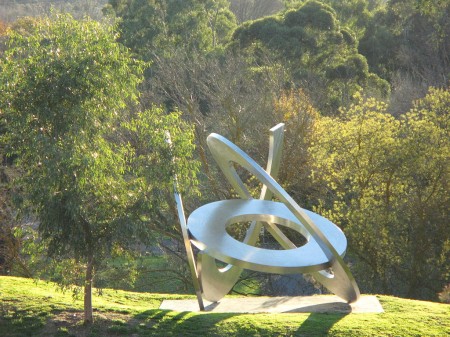
“Rings of Saturn” by Inge King, 2005-06, as displayed in the gardens at the Heide Museum of Modern Art in Bulleen, Melbourne, Australia, viewed from Heide I. Photo taken by Nick Carson in June 2009. WikiCommons Image.
Biography to be continued …….
Notes

